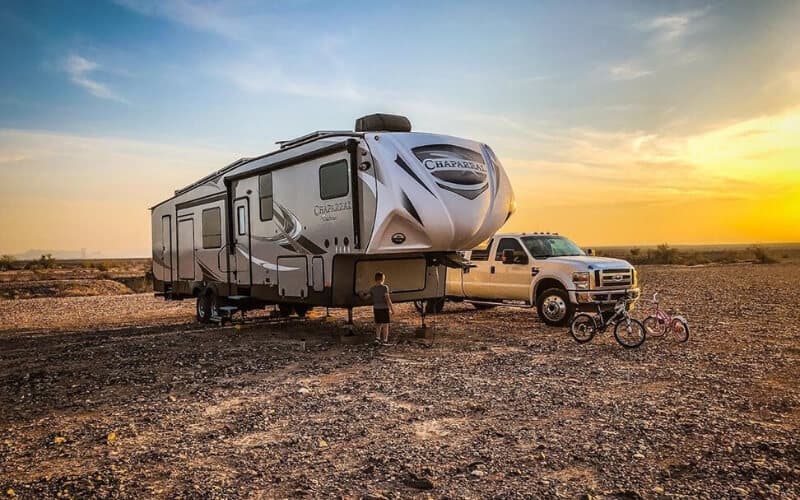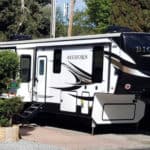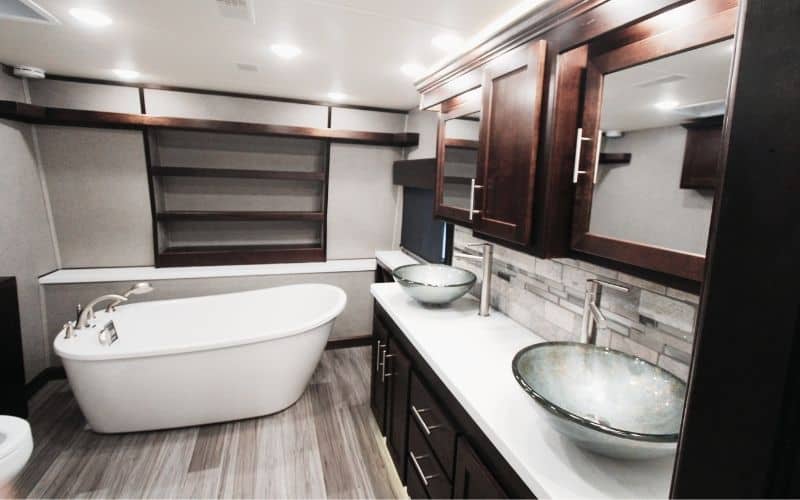Low-quality construction, strange floor plans, poor warranties, and cheap materials are the main reasons to avoid some fifth-wheel RV brands. I’ve been living in several fifth-wheel trailers of different brands. And I know some brands have a reputation for creating issues for their owners, such as Dutchmen Voltage, Coachmen Chaparral, and some others as well.
The Federal Motor Carrier Safety Administration, DOT 393, states that you should regularly maintain your fifth-wheel camper. If you’ve invested in an unreliable brand, maintaining your trailer every now and then will cost you more. Plus, it can pose problems and emergencies during your adventures.
A fifth-wheel trailer is a major investment. If you’re a new buyer in the market, it’s natural for you to feel leery about where to invest your hard-earned money. Therefore, I’m writing a detailed review of some of the common problematic fifth-wheel trailers in the market that you may want to avoid.
5 Worst Fifth Wheel Trailer Brands To Avoid In 2023
While some RVs can attract you by their flashing outlook, I’ve gathered this list based on buyers’ experiences. So, without further ado, here are the five worst 5th wheel brands.
- Jayco
- Dutchmen
- Winnebago
- Coachmen
- Keystone
These brands have a reputation for leaks, corrosion, and even plumbing troubles. Keep reading to analyze each of these brands thoroughly.
Jayco
Image source: Southern RV
Often known as the largest manufacturer of high-quality fifth-wheel RVs in the world, this brand is not always up to par. As per my experience with Jayco, many of their RVs are worth the praise as they’re sleek and luxurious and can be simple to personalize. Here are some specs of Jayco’s fifth-wheel campers:
- Dry Weight of 10,755 lbs.
- Payload Capacity of 1,745 lbs.
- GVWR of 12,500 lbs.
- Hitch Weight of 1,350 lbs.
- Total Fresh Water Tank Capacity of 75 gallons
- Total Gray Water Tank Capacity of 97.5 gallons
- Total Black Water Tank Capacity of 32.5 gallons
- Three slideouts
- Sleep up to 4 people
But not all of the Jayco models are crafted up to your expectations, which is why you might want to avoid this one. Let’s look at why you should pass on this brand.
Why To Avoid The Jayco Fifth-Wheel Trailers
Apart from Jayco being renowned for being the best manufacturer, it is also famous for spending more time in the service department than in your garage. Here are some of the disadvantages of the Jayco fifth-wheel campers:
- Use of low-quality and inexpensive materials
- Overheating engine
- Poor craftsmanship
- Heater issues
- Regular and expensive repair
To Conclude: If you’re not looking to throw your money into repairing very often, stay away from this fifth-wheel brand.
Dutchmen
Image source: Big Truck Big RV
Despite having a spotty history, Dutchman claims to be the fifth-wheel industry leader since 1988. Later on, this entry-level manufacturer of fifth-wheel campers merged with Keystone. And unfortunately, this low-tier company is plagued with laziness and is still stuck in the 80s. However, the “three-year warranty” is the only advantage this brand has to offer. Here are some of the specs of the famous model, the Voltage 5th Wheel Camper:
- Dry Weight of 13,512 lbs.
- Payload Capacity of 3,288 lbs.
- Hitch Weight of 2,812 lbs.
- Total Fresh Water Tank Capacity of 160 gallons
- Total Gray Water Tank Capacity of 86 gallons
- Total Black Water Tank Capacity of 38 gallons
- Three slideouts
- Sleeps up to 7 people
- Cargo Area Length of 12.5 feet
- Air Conditioning 30,000 BTUs per hour
Now, facing constant complaints, the company has started to lose its value. Let’s look at these consistent problems that are headaches to many owners.
Why To Avoid The Dutchmen Voltage Fifth-Wheel Camper
The Dutchmen RVs are known as the best for beginners and are affordable, but they are also known for their plumbing problems. Apart from that, here are some other disadvantages of the Voltage model of Dutchmen:
- Garage-like interior
- Ventilation issues on humid days
- Poor material quality
- Improper cooling of rooftop AC
- Poor construction of bathroom and kitchen
- Unpleasant rubber smell
To Conclude: Dutchmen are renowned for having a bad reputation for falling apart RVs as they get old.
Winnebago
Image source: Josh the RV Nerd at Bish’s RV
Winnebago had a strong presence in the motorhome industry throughout the 1980s and into the early 1990s. Even today, you will witness many of their campers on the road, mostly class A, B, and C. However, their fifth-wheel RV is not quite reliable. Here are the specs of Winnebago’s fifth-wheel motorhome.
- Dry Weight of 5,780 lbs.
- GVWR of 7,700 lbs.
- Hitch Weight of 1,060 lbs.
- Total Fresh Water Tank Capacity of 31 gallons
- Total Gray Water Tank Capacity of 50 gallons
- Total Black Water Tank Capacity of 25 gallons
- Sleeps up to 6 people
- 13,500 BTU air conditioner
- One slideout
While history praises this brand and its customer loyalty, it compromised production quality to expand its business. Let’s see what qualities made them a brand to avoid.
Why To Avoid The Winnebago Minnie Fifth-Wheel Camper
Winnebago Campers is recently known for its subpar construction among many buyers, which affects its technical and aesthetical aspects. These issues are listed below:
- Poor quality materials
- Not-so-good interior
- Poor construction
- Smaller water tank
- Poor plumbing and leaking pipes
- Leaking and underpowered AC
These problems also extend to the entire new RV lines of Winnebago.
To Conclude: If you go with the Winnebago Minnie fifth-wheel camper, you are dedicating yourself to only keeping it at a full-service RV campground.
Coachmen
Image source: Big Truck Big RV
The Coachmen brand has been in the fifth-wheel RV manufacturing industry since 1964. This brand is well-known for its dependability, and it has improved its motorhomes to meet the needs of contemporary RVers. Here are the specs of Coachmen’s fifth-wheel RVs:
- Dry Weight of 10,520 lbs.
- Payload Capacity of 1,480 lbs.
- GVWR of 12,000 lbs.
- Hitch Weight of 1,880 lbs.
- Total Fresh Water Tank Capacity of 48 gallons
- Total Gray Water Tank Capacity of 90 gallons
- Total Black Water Tank Capacity of 45 gallons
- Sleeps only four people
- 15,000 BTU air conditioner
However, several good reasons make this brand on the list of fifth-wheel campers to avoid. Let’s look at those aspects.
Why To Avoid The Coachmen Chaparral Fifth-Wheel Camper
Chaparral, one of the models of Coachmen Campers, is a perfect example of why you should avoid it. Here are some of its drawbacks:
- Leaking roof
- Poor build quality
- Illogical interior
- Problematic AC
- Defective design
- Absurd water tank
- Expensive as compared to others
Pro Tip: Coachmen’s Chaparral fifth-wheel motorhome might not be ideal for you if you plan to travel with large groups, as it accommodates only four individuals to sleep.
Keystone
Image source: Myles RVs
For the most part, Keystone has earned a reputation for providing quality RVs. Here are the specs of Keystone’s fifth-wheel motorhome.
- Dry Weight of 11,202 lbs.
- Payload Capacity of 2,788 lbs.
- GVWR of 13,990 lbs.
- Hitch Weight of 1,990 lbs.
- Total Fresh Water Tank Capacity of 81 gallons
- Total Gray Water Tank Capacity of 76 gallons
- Total Black Water Tank Capacity of 38 gallons
However, in recent years, they have started infusing questionable build quality and material selection into their line. Let’s analyze those issues and answer why you should avoid this brand.
Why To Avoid The Keystone Cougar
Apart from using poor material, many other reasons add up to why you should avoid spending your money on Keystone’s Cougar model. Here is a list of those reasons:
- Enormous water tank
- Poor plumbing
- Zero quality assurance
- Regular electrical problems
- Absurd interior installment
Pro Tip: If you are going to do a lot of backwoods boondocking, you’ll want to prioritize a model with an absorption refrigerator.
FAQs
What RV manufacturers have the most complaints?
Here is a list of RV manufacturers you should avoid to get the best deal for your money:
- Jayco
- Dutchmen
- Winnebago
- Coachmen
- Keystone
What are the best fifth-wheel manufacturers?
Here are the five best-selling fifth-wheel brands in 2023:
- Grand Design
- Forest River
- Crossroads
- Heartland
- Northwood
Final Words
Whether buying new or used, a fifth-wheel camper is a significant investment. So, before sinking your hard-earned dollars into one, take the time to shop around, read reviews, and consider how you are most likely to use the RV.
For instance, if you hear complaints about water leaks like the Coachmen Chaparral, you might want to think long and hard. And if you will be camping in hot conditions, you should avoid fifth-wheel campers like the Winnebago Minnie with its 13,000 BTU air conditioner. Remember to shop around and make a deal with a reliable vendor to get the best deal.
Are you looking for small fifth-wheel trailers to buy? I’ve compiled eight of the best fifth-wheelers here, especially if you’re always on the go!



![Top 5 Portable RV Waste Tanks for [currentyear] - Best RV Portable Waste Tanks for Adventurers 3 Best RV Portable Black & Gray Waste Tanks](https://www.rvingknowhow.com/wp-content/uploads/2020/04/Best-RV-Portable-Black-Gray-Waste-Tanks-150x150.jpg)
![6 Best Four Season Fifth Wheel RVs for Full-Time Living in [currentyear] 4 Best Four Season Fifth-Wheel Trailers](https://www.rvingknowhow.com/wp-content/uploads/2021/12/Best-Four-Season-Fifth-Wheel-Trailers.jpg)
![4 Best A-Frame Campers with Bathrooms in [currentyear] 5 Best A-Frame Campers With Bathrooms(1)](https://www.rvingknowhow.com/wp-content/uploads/2021/11/Best-A-Frame-Campers-With-Bathrooms1.jpg)
